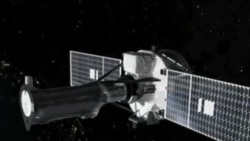WASHINGTON —
The U.S. space agency NASA is preparing to launch a new mission to study the sun. The Interface Region Imaging Spectrograph, or IRIS, will observe the way solar material gathers energy and heats up as it moves through the sun's lower atmosphere.
The upper layer of the sun's atmosphere, known as the corona, is thousands of times hotter than the sun's surface.
Scientists want to figure out how that happens, so they are preparing a mission to study the sun's so-called interface region, the area between the sun's photosphere and its corona.
Energy and plasma that flow through the interface region have an impact on us here on Earth. That region is the source of the sun's ultraviolet emission, which has an effect on our planet's climate, as well as the near-Earth space environment. Energy that seeps through the interface region drives solar wind.
That's where NASA's Interface Region Imaging Spectrograph, or IRIS, mission comes into play. IRIS is a small satellite with the ability to perform complex solar observations.
Alan Title, the IRIS principal investigator based at Lockheed Martin's Advanced Technology Center in California, spoke to reporters about the mission's importance.
"What we want to discover is what the basic physical processes are that transfer energy and material from the surface of the sun out to the outer atmosphere to the corona," he explained. "And, remember, the corona extends throughout the heliosphere. We live in the sun's outer atmosphere."
High-resolution images & high temperatures
IRIS will provide high-resolution images that even will show individual structures of energy as they rapidly stretch away from the sun. The U.S. space agency says IRIS images will be three-to-four times as detailed as those from NASA's Solar Dynamics Observatory.
IRIS also will provide spectra, data that reveals information about multiple wavelengths of light at once.
NASA says IRIS will observe a range of temperatures from about 5,000 to 65,000 degrees Celsius, and up to about 10 million degrees Celsius during solar flares. But IRIS will not be observing the sun from up close.
"IRIS flies around the Earth so it only gets about 600 kilometers closer to the sun than we are here on Earth, and that's about 92 million miles away," said principal investigator Alan Title. "So it's really not very much closer to the sun."
The $181 million mission is set to last two years, but scientists say the solar explorer could function much longer.
IRIS is set to launch aboard a Pegasus XL rocket from Vandenberg Air Force Base in California on June 26.
The upper layer of the sun's atmosphere, known as the corona, is thousands of times hotter than the sun's surface.
Scientists want to figure out how that happens, so they are preparing a mission to study the sun's so-called interface region, the area between the sun's photosphere and its corona.
Energy and plasma that flow through the interface region have an impact on us here on Earth. That region is the source of the sun's ultraviolet emission, which has an effect on our planet's climate, as well as the near-Earth space environment. Energy that seeps through the interface region drives solar wind.
That's where NASA's Interface Region Imaging Spectrograph, or IRIS, mission comes into play. IRIS is a small satellite with the ability to perform complex solar observations.
Alan Title, the IRIS principal investigator based at Lockheed Martin's Advanced Technology Center in California, spoke to reporters about the mission's importance.
"What we want to discover is what the basic physical processes are that transfer energy and material from the surface of the sun out to the outer atmosphere to the corona," he explained. "And, remember, the corona extends throughout the heliosphere. We live in the sun's outer atmosphere."
High-resolution images & high temperatures
IRIS will provide high-resolution images that even will show individual structures of energy as they rapidly stretch away from the sun. The U.S. space agency says IRIS images will be three-to-four times as detailed as those from NASA's Solar Dynamics Observatory.
IRIS also will provide spectra, data that reveals information about multiple wavelengths of light at once.
NASA says IRIS will observe a range of temperatures from about 5,000 to 65,000 degrees Celsius, and up to about 10 million degrees Celsius during solar flares. But IRIS will not be observing the sun from up close.
"IRIS flies around the Earth so it only gets about 600 kilometers closer to the sun than we are here on Earth, and that's about 92 million miles away," said principal investigator Alan Title. "So it's really not very much closer to the sun."
The $181 million mission is set to last two years, but scientists say the solar explorer could function much longer.
IRIS is set to launch aboard a Pegasus XL rocket from Vandenberg Air Force Base in California on June 26.









